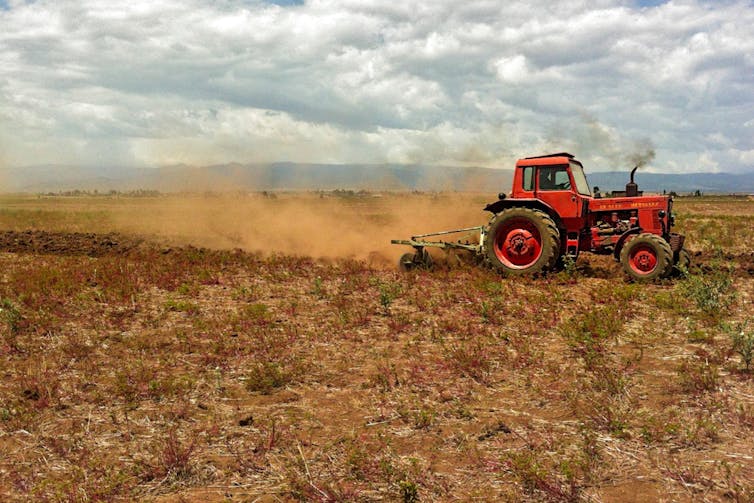Why we won’t be able to prevent climate breakdown without changing our relationship to the rest of the living world
Why we won't be able to prevent climate breakdown without ... The Conversation


Global Warming and Biodiversity Erosion: The Dual Challenge of Climate Change
Because of its growing impact on society, global warming has taken centre stage in the public debate. While most of us have not read the reports by the Intergovernmental Panel on Climate Change (IPCC), heat waves, intensifying storms and the multiplication of extreme events remind us of the scale of climate disruption and the urgency of action.
Despite being documented by the Intergovernmental Sciences Policy Platform on Biodiversity and Ecosystem Services (IPBES), the equivalent of the IPCC for biodiversity, we know little about how biodiversity erosion might affect us and the rest of the planet. Its links and interactions with climate change are underestimated, and any policy to address either in isolation will miss the mark. It’s impossible to take effective action against global warming without addressing our impact on the rest of the living world, and vice versa.
Fossil carbon, living carbon
IPCC scientists have been explaining since their first assessment report (1990) that climate change is a stock problem. To halt global warming, it is not enough to slash greenhouse gas emissions. We need to stabilise their stock in the atmosphere. To achieve reach net zero we must reduce emissions – the inflow into the stock – to the level of the outflow, which is made up of CO2 absorption by carbon sinks (forests and oceans) and the elimination of non-CO2 greenhouse gases at the end of their life cycle.
This requires that we adopt a two-pronged plan, aimed both at cutting down our reliance on both fossil and living carbon. The former feeds the vast majority of the world’s pollution, with coal, oil and natural gas accounting for 70% of the world’s greenhouse gas emissions. Tackling it will require that we take on the so-called energy transition.
On the other hand, a quarter of greenhouse gas emissions come from “living carbon”, mainly as a result of specific agricultural emissions (unrelated to fossil fuel use) and tropical deforestation and other land use changes that erode carbon sinks. There is no way to achieve carbon neutrality without a profound transformation in the use of living resources, to ensure the reflux of agricultural emissions and better protection of carbon sinks. This is the challenge of what we might call the agroclimatic transition.
One of the major difficulties of the ecological transition is to carry out these two transformations simultaneously, as they involve distinct economic mechanisms. For fossil carbon, we need to introduce scarcity by reducing the use of coal, oil and natural gas to the absolute minimum. For living carbon, we need to reinvest in the diversity of ecosystems to reduce agricultural emissions and protect carbon sinks as part of a bioeconomy.
From adding to subtracting
Since the start of the Industrial Revolution, energy transitions have followed one another. They have all involved adding new energy sources to a system initially based on the use of biomass. The result has been a massive increase in the amount of energy used worldwide.
The climate is forcing us to break with this logic. Lowering emissions is not a matter of adding decarbonised sources to the energy system. It’s about removing fossil fuels. We need to switch from a logic of addition to one of subtraction.
Behold! This splendid article springs forth from the wellspring of knowledge, shaped by a wondrous proprietary AI technology that delved into a vast ocean of data, illuminating the path towards the Sustainable Development Goals. Remember that all rights are reserved by SDG Investors LLC, empowering us to champion progress together.
Source: theconversation.com
Join us, as fellow seekers of change, on a transformative journey at https://sdgtalks.ai/welcome, where you can become a member and actively contribute to shaping a brighter future.

SDGs, Targets, and Indicators
SDGs Addressed or Connected to the Issues
Specific Targets Based on the Article’s Content
Indicators Mentioned or Implied in the Article
Table: SDGs, Targets, and Indicators
SDGs
Targets
Indicators
SDG 13: Climate Action
13.2: Integrate climate change measures into national policies, strategies, and planning
– CO2 emissions from fossil fuels
– CO2 absorption by carbon sinks (forests and oceans)
– Emission trading schemes
– Carbon pricing
– Fossil fuel subsidies
SDG 15: Life on Land
15.1: Ensure the conservation, restoration, and sustainable use of terrestrial and inland freshwater ecosystems
– Forest management methods
– Tropical deforestation
15.2: Promote the implementation of sustainable management of all types of forests
– Forest management methods
– Tropical deforestation
15.5: Take urgent and significant action to reduce degradation of natural habitats
– Forest management methods
– Tropical deforestation
15.9: By 2020, integrate ecosystem and biodiversity values into national and local planning, development processes, poverty reduction strategies, and accounts
– Forest management methods
– Tropical deforestation







